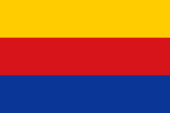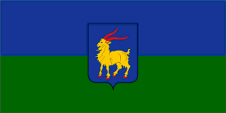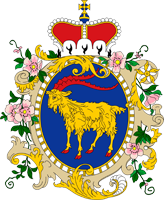Istrien |
|
|
|
| Übersicht – Contents: | |
Istrien |
|
|
|
| Übersicht – Contents: | |
Flaggen – Flags: |
|
 |
bis/to 1918, Landesflagge (Landesfarben) – Flag of the country (colours), Seitenverhältnis – ratio = 2:3, Quelle/Source nach/by: Flags of the World |
 |
seit/since 03.10.1994, Flagge der kroatischen Gespanschaft Istrien – flag of the Croatian District of Istria, Quelle/Source: nach/by Wikipedia (D) |
|
|
|
Bedeutung/Ursprung der Flagge – Meaning/Origin of the Flag: |
|
| Das Land hatte, wie alle Kronländer der österreichischen Krone, seine eigenen, sogenannten Landesfarben, die unter anderem auf horizontal getreiften zwei- oder dreistreifigen Flaggen gezeigt wurden. Die Landesfarben waren sehr oft dem jeweiligen Wappen des Kronlandes entnommen oder wurden duch eine weitere, nicht im Wappen enthaltene Farbe ergänzt, oder sie gingen auf ältere Modelle des Landeswappens zurück (z.B. Krain). Offiziell waren die Landesfarben aber nie geregelt oder festgelegt worden, so dass deren Reihenfolge in der Praxis of variierte oder die Farben gar an sich abwichen. |
The country had – like all the other crown lands of the Austrian
crown – its own colours (Landesfarben), which were used amongst others on
horizontally two- or three-striped flags. The colours (Landesfarben) were very often taken from the respective coat of arms of the country or were supplemented by another colour, which not appears in the coat of arms, or they went back to older models of the coat of arms (e.g. Carniola). Officially, the colours had never been regulated or stipulated, so that their sequence varied in practice or even the colors deviated. |
| Der österreichische Heraldiker Hugo Gerard Ströhl (1851–1919) hat sich wohl als erster des Themas angenommen und wahrscheinlich um das Jahr 1890 herum die Landesfarben auf den Flaggen bei den jeweiligen Landesbehörden abgefragt und zusammengestellt. | The Austrian heraldist Hugo Gerard Ströhl (1851–1919) was probably the first to take care of it and asked for the colors (Landesfarben) on the flags at the respective state authorities around 1890 and compiled them. |
| Das Kronland Istrien verwendete als Landesfarben eine Flagge die drei horizontale Streifen in Gold, Rot und Blau zeigte. Die Farben stammen vom Wappen Istriens: goldener Ziegenbock mit roter Bewehrung auf blauem Schild. | The Crown
Land of Istria used as colours of the country a flag which showed three
horizontal stripes in gold, red and blue. The colours descend from the coat
of arms of Istrien: blue goat-buck with red arms on a blue shield. |
| Quelle/Source: Österreichisch-Ungarische Wappenrolle, Flags of the World, Volker Preuß | |
Wappen – Coat of Arms: |
|
 |
bis/to 1918, Wappenschild von Istrien – blazon of Istria, Quelle/Source nach/by: Ströhl, Wappenrolle Österreich-Ungarns, 1890, via austria-forum.org |
 |
ca.1890–1918, Wappen der Markgrafschaft Istrien – Coat of arms of the Margraviate of Istria, Quelle/Source, nach/by: Ströhl, Wappenrolle Österreich-Ungarns, 1890, via Wikipedia (D) |
 |
Wappen von Kroatien – Coat of arms of Croatia, Quelle/Source, nach/by: Wikipedia (D) |
Bedeutung/Ursprung des Wappens – Meaning/Origin of the Coat of Arms: |
|
| Das Wappen zeigt eine goldene Ziege mit roter Bewehrung auf einem blauem Schild. Das Wappenbild geht auf die Venezianer zurück, die den westlichen Teil von Istrien vom 9. Jahrhundert bis 1797 beherrschten. | The coat of arms of Istria shows a golden goat with red arms on a blue shield. The central image of the coat of arms goes back to the Venetians, who ruled the western part of Istria from the 9th century to 1797. |
| Der österreichische Heraldiker Hugo Gerard Ströhl hat das Wappen um 1890 mit Apfelblüten umgeben, welche die Bedeutung des Landes als Obstbauregion hervorheben sollten. | The Austrian heraldist Hugo Gerard Ströhl surrounded the coat of arms ca. 1890 with Apple blossoms, to emphasize the importance of the country as a fruit-growing region. |
| Istriens Heraldik erscheint seit 1992 in einem der fünf Regionalwappen im Schildhaupt des Staatswappens von Kroatien. | The heraldry of Istria appears since 1992 in one of the five regional scutcheons in the upper part of the coat of arms of Croatia. |
| Quelle/Source: Österreichisch-Ungarische Wappenrolle, Wikipedia (D), Volker Preuß | |
|
Landkarte der Kronländer des Küstenlandes – Map of the crown lands of the Austrian-Illiric Littoral: |
|
| Landkarte/Map: Volker Preuß |
| die Kronländer Österreich-Ungarns – Crown Lands of Austria-Hungary: |
|
| Quelle/Source: Volker Preuß |
Zahlen und Fakten – Numbers and Facts: |
|
|
|
|
|
|
|
|
|
|
|
|
|
|
|
|
Geschichte: |
| Antike ·
Besiedlung durch keltische und illyrische Stämme ca. 177 v.Chr. · die Eroberung Istriens durch das Römische Reich ist abgeschlossen, zur Provinz Italia 395 · bei der Teilung des Römischen Reiches kommt das heutige Istrien an das Weströmische Reich 476–489 · Istrien gehört zum Reich des Odoaker 489–545 · Istrien gehört zum Reich der Ostgoten 545–569 · Istrien gehört zum Oströmischen Reich 6. Jahrhundert · Besiedlung durch Slawische Stämme 789 · das heutige Istrien wird durch das Frankenreich der Karolinger unterworfen und kommt zur neu gegründeten "Markgrafschaft Friaul", die Küste wird von der Stadt Venedig für die kommenden 1000 Jahre besetzt 9. Jahrhundert · die Markgrafschaft Friaul kommt zur neu gegründeten Markgrafschaft Verona 952 · die Markgrafschaft Verona kommt an Bayern 976 · die Markgrafschaft Verona kommt an Kärnten 1040 · Gründung einer Markgrafschaft Istrien als Markgrafschaft des Heiligen Römischen Reiches Deutscher Nation 1077 · Istrien kommt teilweise an das Patriarchat von Aquileia 1170 · die Markgrafschaft Istrien kommt an das Haus Andechs 1208 · die Markgrafschaft Istrien kommt an das Haus Wittelsbach (Bayern) und wird an das Patriarchat von Aquileia abgetreten 14. Jahrhundert · die Grafen von Görz und das Haus Habsburg erwerben große Teile des Hinterlandes von Istrien 1374 · Aussterben des Hauses Görz, das Haus Habsburg erwirbt dessen Territorien in Istrien 1797–1809 · Französische Revolutionskriege: ein Teil Österreichs (Steiermark) wird 1797 von den Franzosen besetzt 26.12.1805 · Friede von Preßburg zwischen Österreich und Frankreich (Napoléon I.) nach dem 3. Koalitionskrieg, alle venezianischen Besitzungen in Istrien kommen an Frankreich, werden zunächst Italien angegliedert aber wenig später zum Herzogtum Istrien erhoben 1809 · Friede von Wien, Österreich verliert Salzburg, das Innviertel, Westgalizien und Teile von Ostgalizien und tritt Istrien, Triest, Görz, Krain, Kärnten, Kroatien, und Dalmatien an Frankreich ab, die 1810 zu den französischen "Illyrischen Provinzen" zusammengefasst werden 1813 · Österreich erklärt Frankreich (Napoléon) den Krieg, Istrien wird von Österreich zurückerobert 1814/1815 · Wiener Kongress, Neuordnung Europas nach der Ära Napoléon, das Kaiserreich Österreich (Haus Habsburg) erhält die 1809 verlorenen Gebiete zurück und erwirbt zusätzlich die in Istrien gelegenen Territorien der aufgelösten Republik Venedig; ganz Istrien, Triest, Görz, Kärnten und Krain werden zum Habsburgischen Königreich Illyrien zusammengefasst, Dalmatien und Kroatien werden wieder an Ungarn (unter den Habsburgern, Teil des Kaiserreichs Österreich) angeschlossen 1848/1849 · Revolution in Wien, Bürgerkrieg zwischen Ungarn und Kroaten, Aufstände in Prag, Mailand und Venedig, daraufhin dankt Kaiser Ferdinand I. ab und Franz Joseph I. von Habsburg wird neuer Kaiser, die Aufstände werden niedergeschlagen und er erlässt eine neue Verfassung: die Titular-Erblande der Habsburger im Kaiserreich Österreich werden zu Kronländern mit eigenen Landtagen umgewandelt, der dalmatische Landtag lehnt den Anschluss an Kroatien ab, das Königreich Dalmatien wird ein eigenes Kronland der österreichischen Krone, Kroatien und Slawonien werden zum "Königreich Kroatien und Slawonien" vereinigt, das als Nebenland bei der ungarischen Krone verbleibt, Auflösung des Königreichs Illyrien: Aufteilung in die Kronländer Krain, Kärnten, Küstenland, Kroatien und Slawonien und Dalmatien 1861 · neue österreichische Verfassung, die drei Bestandteile des Küstenlandes, Markgrafschaft Istrien, Gefürstete Grafschaft Görz und Gradisca, Reichsunmittelbare Stadt Triest mit ihrem Gebiet werden eigene Kronländer mit eigenen Parlamenten, allerdings unter einem gemeinsamen Statthalter, dem Landeschef des Österreichisch-Illirischen Küstenlands mit Sitz in Triest 1914–1918 · Erster Weltkrieg, danach Zusammenbruch der Kaiserlich-Königlichen Monarchie, Zerfall von Österreich-Ungarn in Nationalstaaten 10.09.1919 · Friedensvertrag von Saint-Germain nach dem Ersten Weltkrieg, Österreich muss Istrien an Italien abtreten, als "Provincia di Istria" Italien angeschlossen 1939–1945 · Zweiter Weltkrieg, in Istrien kämpfen zwischen 1941 und 1945 kroatische und slowenische Partisanen für einen Anschluss Istriens an Jugoslawien 13.10.1943 · Kapitulation Italiens, daraufhin besetzt das Deutsche Reich unter anderem auch Istrien 1945 · Eroberung und Besetzung der Region durch jugoslawische Partisanen gegen Ende des zweiten Weltkriegs, Vertreibung und teilweise auch Ermordung des größten Teils der im Lande verbliebenen deutschen und italienischen Zivilbevölkerung 29.11.1945 · Ausrufung der "Föderativen Volksrepublik Jugoslawien" (einschließlich Istriens), Istrien kommt dabei größtenteils an Kroatien, der Nordwesten kommt zum unabhängigen Staat "Freie Stadt Triest" 1954 · das Gebiet der Freien Stadt Triest wird zwischen Italien und Jugoslawien (Slowenien und Kroatien) aufgeteilt 1975 · Vertrag von Osimo zwischen Italien und Jugoslawien, Regelung des genauen Grenzverlaufs, Schutz der italienischen Minderheit in Jugoslawien 25.06.1991 · Slowenien und Kroatien erklären ihre Unabhängigkeit von Jugoslawien |
History: |
| antiquity
· settlement by Celtic and Illyrian tribes ca. 177 B.C. · the conquest of Istria by the Roman Empire is finished, to the Province of Italia 395 · at the partition of the Roman Empire today's Istria comes to the West Roman Empire (Rome) 476–489 · Istria belongs to the Empire of the Odoaker 489–545 · Istria belongs to Empire of the Eastern Goth 545–569 · Istria belongs to the East Roman Empire (Byzantium) 6th century · settlement by Slavic tribes 789 · the region becomes subjected by the Frankish Empire of the Carolingians, the region comes to the Margraviate of Friaul, the coast becomes occupied by the City of Venice for the next 1000 years 9th century · the Margraviate of Friaul comes to the new established Margraviate of Verona 952 · the Margraviate of Verona comes to Bavaria 976 · the Margraviate of Verona comes to the Duchy of Carinthia 1040 · formation of an Margraviate of Istria as a Margraviate of the Holy Roman Empire of German Nation 1077 · Istria comes partially to the Patriarchate von Aquileia 1170 · the Margraviate of Istria comes to the House of Andechs 1208 · the Margraviate of Istria comes to the House of Wittelsbach (Bavaria) and becomes ceded to the Patriarchate von Aquileia 14th century · the Counts of Gorizia (Goerz) and the House of Habsburg acquire large parts of the hinterland of Istria 1374 · vanish of the House of Goerz, the House of Habsburg acquires its territories in Istria 1797–1809 · French Revolutionar Wars, parts of Austria (Styria) become occupied by the French in 1797 12th of May 1797 · Peace of Campo Formio between Austria (House of Habsburg) and France (Napoléon I.), all Venetian possessions in Istria come to the House of Habsburg 1809 · Peace of Vienna, Austria loses Salzburg, the Inn Quarter, Western Galicia and parts of Eastern Galicia and cedes Istria, Trieste, Gorizia, Carniola, Carinthia, Croatia, and Dalmatia to France, which were merged in 1810 to the French "Illyrian Provinces" 1813 · Austria declares war on France (Napoléon), Istria is conquered back by Austria 1814/1815 · Congress of Vienna, realignment of Europe after the era Napoléon, the Empire of Austria (House of Habsburg) acquires back the in 1809 lost territories and additionally acquires the territories of the dissolved Republic of Venice in Istria; whole Istria, Trieste, Gorizia, Carinthia and Carniola become merged to the Habsburg's Kingdom of Illyria, Dalmatia and Croatia become re-annexed to Hungary (under the Habsburgs, part of the Empire of Austria) 1848/1849 · revolution in Vienna, civil war between Hungarians and Croats, riotings in Prague, Mailand and Venice, as a result of that Emperor Ferdinand I. resigns and Franz Joseph I. of Habsburg becomes new Emperor, the riotings become suppressed and he enacts a new constitution: the titular hereditary territories of the Habsburgs in the Austrian Empire become converted to crown lands with their own Landtag (parliament), the Landtag of Dalmatia rejects the annexion to Croatia, the Kingdom of Dalmatia becomes an own crown land of the Austrian crown, Croatia and Slavonia become united to the "Kingdom of Croatia and Slavonia", which remains as a subsidiary country under the Hungarian crown, dissolution of the Kingdom of Illyria: division in the crown lands of Carniola, Carinthia, Littoral, Croatia and Slavonia and Dalmatia 1861 · new Austrian constitution, the three components of the Littoral, Margraviate of Istria, Princely County of Gorizia and Gradisca and the Imperial Free City of Trieste and its surrounding area, become own crown lands with their own parliaments, but under a common head of state, the governor of the Austrian-Illiric Littoral with his seat in Trieste 1914–1918 · First World War, thereafter breakdown of the imperial-royal monarchy, disintegration of Austria-Hungary in national states 10th of September 1919 · Treaty of Peace of Saint-Germain after the First World War, Austria has to cede Istria to Italy, affiliated to Italy as "Provincia di Istria" 1939–1945 · Second World War, in Istria fight between 1941 and 1945 Croatian and Slovanian partisans for an annexion of Istria by Yugoslavia 13th of October 1943 · capitulation of Italy, as a result of that the German Empire occupys all other Istria territories 1945 · conquest and occupation of the area by Yugoslav partisans at the end of the Second World War, expulsion and partially even assassination of the largest part of the in the country remained German and Italian civilian population 29th of November 1945 · proclamation of the "Federative People's Republic of Yugoslavia" (incl. Istria), Istria comes in this way mainly to Croatia, the northwest comes to the independent state "Free Town of Triest" 1954 · the area of the Free Town of Triest becomes shared out between Italy and Yugoslavia (Slovenia and Croatia) 1975 · Treaty of Osimo between Italy and Yugoslavia, adjustment of the exact course of the border boundary, protection of the Italian minority within Yugoslavia 25th of June 1991 · Slovenia and Croatia declare its independence from Yugoslavia |
| Quelle/Source: Atlas zur Geschichte, Wikipedia (D), RetroBib Retrobibliothek, Discovery '97, Volker Preuß |
| geschichtliche Landkarten – historical Maps: | |
|
|
|
|
|
|
| Landkarte/Map: Volker Preuß | |
Ursprung des Landesnamens – Origin of the Country's Name: |
|
| Der Name "Istrien" geht auf das illyrische Volk der "Histrier" zurück, das in der Antike hier lebte. Der Name wurde von den Römern vergeben, die das Land 177 v.Chr. eroberten. Für sie waren die illyrischen Bewohner der Halbinsel Piraten. Da keine sprachlichen Überliefeungen der Histrier existieren, kann man, wenn man will, in dem Wort "Histrier" das lateinische Wort "Histrionia" finden, was "Schauspielerei" heißt, und möglicherweise ein Hinweis für die erfindungsreiche Piraterie der damaligen illyrischen Bewohner der Halbinsel war, und nicht der wirkliche Name des ursprünglich hier lebenden Volkes. |
The name "Istria" goes
back to the Illyrian people of the "Histri" who lived here in antiquity. The
name was given by the Romans, who conquered the country in 177 B.C. For
them, the Illyrian inhabitants of the peninsula were pirates. Since there are no linguistic bequests of the Histri, you can, if you want, find the Latin word "Histrionia" in the word "Histri", which means "acting". This may have been a reference to the inventive piracy of the Illyrian inhabitants of the peninsula at that time, and not the real name of the people who originally lived here. |
| Quelle/Source: Wikipedia (D), Ausführliches und möglichst vollständiges deutsch-lateinisches Lexicon, von Immanuel Johann Gerhard Scheller, Leipzig, 1789, Volker Preuß | |
| • Reich der Österr. Habsburger (bis 1804) • Kaiserreich Österreich (1804–1867) • Österreich-Ungarn (1867–1918) • Republik Österreich (seit 1918) |
• Empire of the Austrian Habsburgs (to 1804) • Empire of Austria (1814–1867) • Austria-Hungary (1867–1918) • Republic of Austria (since 1918) |